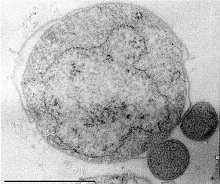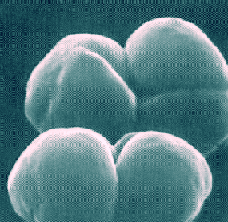
The Thermoproteota are prokaryotes that have been classified as a phylum of the Archaea domain. Initially, the Thermoproteota were thought to be sulfur-dependent extremophiles but recent studies have identified characteristic Thermoproteota environmental rRNA indicating the organisms may be the most abundant archaea in the marine environment. Originally, they were separated from the other archaea based on rRNA sequences; other physiological features, such as lack of histones, have supported this division, although some crenarchaea were found to have histones. Until recently all cultured Thermoproteota had been thermophilic or hyperthermophilic organisms, some of which have the ability to grow at up to 113 °C. These organisms stain Gram negative and are morphologically diverse, having rod, cocci, filamentous and oddly-shaped cells.
The Thermoprotei is a class of the Thermoproteota.
Mollicutes is a class of bacteria distinguished by the absence of a cell wall. The word "Mollicutes" is derived from the Latin mollis, and cutis. Individuals are very small, typically only 0.2–0.3 μm in size and have a very small genome size. They vary in form, although most have sterols that make the cell membrane somewhat more rigid. Many are able to move about through gliding, but members of the genus Spiroplasma are helical and move by twisting. The best-known genus in the Mollicutes is Mycoplasma. Colonies show the typical "fried-egg" appearance.

Acholeplasmataceae is a family of bacteria. It is the only family in the order Acholeplasmatales, placed in the class Mollicutes. The family comprises the genera Acholeplasma and Phytoplasma. Phytoplasma has the candidatus status, because members still could not be cultured.

The Thermodesulfobacteriota are a phylum of thermophilic sulfate-reducing bacteria.
Methanococcus is a genus of coccoid methanogens of the family Methanococcaceae. They are all mesophiles, except the thermophilic M. thermolithotrophicus and the hyperthermophilic M. jannaschii. The latter was discovered at the base of a “white smoker” chimney at 21°N on the East Pacific Rise and it was the first archaeal genome to be completely sequenced, revealing many novel and eukaryote-like elements.

The Desulfurococcales is an order of the Thermoprotei, part of the kingdom Archaea. The order encompasses some genera which are all thermophilic, autotrophs which utilise chemical energy, typically by reducing sulfur compounds using hydrogen. Desulfurococcales cells are either regular or irregular coccus in shape, with forms of either discs or dishes. These cells can be single, in pairs, in short chains, or in aciniform formation.
In the taxonomy of microorganisms, the Methanomicrobiales are an order of the Methanomicrobia. Methanomicrobiales are strictly carbon dioxide reducing methanogens, using hydrogen or formate as the reducing agent. As seen from the phylogenetic tree based on 'The All-Species Living Tree' Project the family Methanomicrobiaceae is highly polyphyletic within the Methanomicrobiales.
Methanomicrobiaceae are a family of archaea in the order the Methanomicrobiales.

In taxonomy, the Methanosarcinaceae are a family of the Methanosarcinales.
In taxonomy, Methanococcoides is a genus of the Methanosarcinaceae.

Acidilobus is a genus of archaea in the family Acidilobaceae.
In taxonomy, Methanimicrococcus is a genus of the Methanosarcinaceae. The members of this genus have been found in pharmaceutical wastewater, and they can contribute to the degradation of organic contaminants.
In taxonomy, Methanolobus is a genus of methanogenic archaea within the Methanosarcinaceae. These organisms are strictly anaerobes and live exclusively through the production of methane, but the species within Methanolobus cannot use carbon dioxide with hydrogen, acetate or formate, only methyl compounds. The cells are irregular coccoid in form and approximately 1 μm in diameter. They do not form endospores. They are Gram negative and only some are motile, via a single flagellum. They are found in lake and ocean sediments that lack oxygen.
In taxonomy, Methanomethylovorans is a genus of microorganisms with the family Methanosarcinaceae. This genus was first described in 1999. The species within it generally live in freshwater environments, including rice paddies, freshwater sediments and contaminated soil. They produce methane from methanol, methylamines, dimethyl sulfide and methanethiol. With the exception of M. thermophila, which has an optimal growth temperature of 50 °C, these species are mesophiles and do not tend to grow at temperatures above 40 °C.
Halorhabdus is a genus of halophilic archaea in the Haloarculaceae. With an extremely high salinity optimum of 27% NaCl, Halorhabdus has one of the highest reported salinity optima of any living organism.
Natrinema is a genus of the Natrialbaceae.
Natronorubrum is a genus in the family Halobacteriaceae.
Methanocalculus is a genus of the Methanomicrobiales, and is known to include methanogens.
In the taxonomy of microorganisms, Candidatus Methanoregula is a genus of the Methanomicrobiales. It was is isolated from an acidic peat bog. It produces methane at the lowest pH of any known organism.







